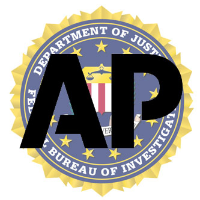Fake News Story May Have Broken Rules, FBI Report Says
 Photo illustration: Steve Straehley/AllGov
Photo illustration: Steve Straehley/AllGov
By Raphael Satter, Associated Press
WASHINGTON — Federal Bureau of Investigation (FBI) officials say there’s no clear evidence the agency violated its own rules when it posed as The Associated Press to unmask a criminal, according to a report obtained through a public records lawsuit.
However, the internal FBI report being made public by the AP and the Reporters Committee for Freedom of the Press says “an argument can be made” that field agents bucked protocol by not informing senior brass in Washington of the 2007 operation.
The sting was aimed at identifying the hoaxer behind a series of bomb threats to Timberline High School in the suburban town of Lacey, Washington.
Agents crafted a fake AP article, digitally booby-trapped it and sent it to the suspect’s MySpace account. Pretending to be an AP reporter, they asked him to review the piece before it was published. When the hoaxer opened what he thought was a story about his exploits, the digital trap was sprung, his location was revealed and he was swiftly arrested.
The FBI’s use of the AP’s name in the operation wasn’t widely known until Chris Soghoian, a technologist with the American Civil Liberties Union, discovered a reference to the bogus news article in a cache of previously released FBI documents in October 2014. The AP called the FBI’s action “unacceptable” and, in a letter to the Justice Department a month later, AP President and CEO Gary Pruitt said the FBI’s tactics amounted to “a theft of our reputation and credibility.”
FBI Director James Comey defended the operation, saying in an editorial that the technique was “proper and appropriate under Justice Department and FBI guidelines at the time.”
But the seven-page “Situation Action Background” report (pdf), drafted by the FBI’s Cyber Division on Oct. 31, 2014, gives a more nuanced take.
It notes that undercover operations involving agents who pose as members of the media are typically categorized as “Group 1,” the label given to sensitive operations flagged to the agency’s Washington headquarters for review and approval. That does not appear to have happened in the Timberline case. The report says it isn’t clear whether the Seattle office ever even told headquarters about their impersonation of AP.
Despite that, the FBI’s Cyber Division found in the Seattle office’s favor, saying it acted reasonably “under the circumstances.”
“Although an argument can be made the reported impersonation of a fictitious member of the media constituted a ‘sensitive circumstance’ that would have made the undercover activity subject to FBI HQ review and approval required for a Group 1 undercover operation, the facts of the case do not clearly indicate that such a sensitive circumstance existed,” the report says.
The “facts of the case” invoked by the report aren’t made clear. The following four pages are heavily redacted.
The report was among 186 pages of material recently turned over to the AP and the Reporters Committee after they teamed up to sue the FBI for more information about the agency’s impersonation of journalists. Both groups are still fighting the FBI for more documents about the bomb hoax case and others like it. In a legal brief filed Monday, they described the government’s disclosure as inadequate and some of its redactions as improper.
“We don’t believe it’s appropriate to fake being a journalist under any circumstances, whatever the FBI’s own findings may be,” AP Executive Editor Kathleen Carroll said. “AP journalists are independent and it is wrong, and potentially dangerous, to create a lie that then links them with government activities.”
To Learn More:
Media Credibility Threatened by FBI Falsification of AP News Story to Locate Bomb Suspect (by Noel Brinkerhoff, AllGov)
AP and Reporters Committee Sue FBI for Release of Records about Impersonating Journalists (by Steve Straehley, AllGov)
- Top Stories
- Unusual News
- Where is the Money Going?
- Controversies
- U.S. and the World
- Appointments and Resignations
- Latest News
- Musk and Trump Fire Members of Congress
- Trump Calls for Violent Street Demonstrations Against Himself
- Trump Changes Name of Republican Party
- The 2024 Election By the Numbers
- Bashar al-Assad—The Fall of a Rabid AntiSemite






Comments